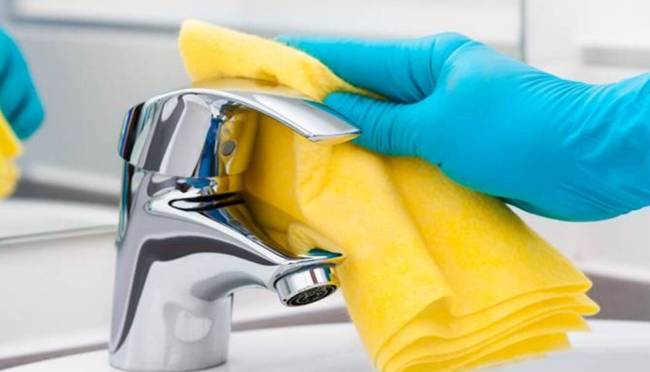It was confirmed this week by the C.D.C. that surfaces have a low risk of transmitting Coronavirus.
Several experts warned of the dangers posed by surfaces when the Coronavirus first spread in the United States last spring. Plastic or stainless steel can survive for days with the virus, according to researchers, and the Center for Disease Control and Prevention warns that if you touch one of these contaminated surfaces, you could become infected if you touch your eyes, nose or mouth.
In response, Americans wiped down groceries, quarantined mail and cleared drugstore shelves of Clorox wipes. The Metropolitan Transportation Authority began disinfecting subway cars every night after Facebook closed two offices for a “deep cleaning.”
As the C.D.C. updated its surface cleaning guidelines this week, it noted that the risk of contracting the virus from touching a contaminated surface is less than 1 in 10,000.
In a White House briefing on Monday, C.D.C. director Rochelle Walensky said that people can become infected with Covid-19 through contact with contaminated surfaces and objects. “However, evidence shows that this route of infection poses a low risk of transmission.”
Scientists say the admission has been long overdue.
Linsey Marr, an expert on airborne viruses at Virginia Tech, said, “Finally.” She added, “While surface cleaning is important, there’s really no evidence that anyone has ever contracted Covid-19 from touching contaminated surfaces.”
Early on, many experts believed that the virus spread primarily through respiratory droplets. Even though these droplets are too heavy to travel long distances through the air, they can still fall onto surfaces and objects.
An emphasis on scrubbing down every surface made sense in this context. Doctor said surface cleaning is more familiar. It’s something we know how to do. You can see people doing it, and you can see the clean surface. Therefore, I think it makes people feel safer.”
Over the last year, it has become increasingly clear that the virus spreads primarily through the air – both in large and small droplets, which can remain aloft for a long time – and that scrubbing door handles and subway seats does little to protect people.
“There is little scientific support for all this concern about surfaces,” says Emanuel Goldman, a microbiologist at Rutgers University, who wrote last summer that the risk has been overblown. You get this virus by breathing. You can’t catch it by touching it.”
The C.D.C. has previously acknowledged that surfaces do not spread the virus most commonly. However, the agency’s statements this week went beyond that.
“The most important part of this update is that they’re clearly communicating to the public the correct, low risk from surfaces, which hasn’t been clearly communicated for the past year,” said Joseph Allen, a building safety expert at Harvard T.H. Chan School of Public Health.
The possibility of catching the virus from surfaces remains theoretical, he added. This requires many things to go wrong: fresh, infectious viral particles to be deposited on a surface, and then a relatively large quantity of them to be quickly transferred to someone’s hand and face. Doctor said that being present on a surface does not necessarily mean that a risk exists.
C.D.C.’s updated cleaning guidelines recommend cleaning with soap and water, along with hand-washing and wearing a mask, to reduce the likelihood of surface transmission. According to the agency, chemical disinfectants are not needed in most everyday situations.
It tells us what we don’t need to do, says Donald Milton, an aerosol scientist at the University of Maryland. A lot of spraying and misting of chemicals isn’t helpful.”
However, the guidelines recommend cleaning and disinfecting a space if Covid-19 has been present within the last day.
According to Doctor during the White House briefing, disinfection should only be done in indoor settings where there has been a suspected or confirmed case of Covid-19 within the last 24 hours. Additionally, fogging, fumigation, and wide-area or electrostatic spraying are not recommended as primary disinfection methods and have several safety risks.
Health care facilities may require more intensive cleaning and disinfection than the new cleaning guidelines.
According to Saskia Popescu, an infectious disease epidemiologist at George Mason University, the new guidance reflects the evolving data on transmission.
It remains important, however, to continue cleaning regularly – and to maintain good handwashing practices – to reduce the chance of contracting not just Coronaviruses but other pathogens as well.
According to Doctor, school and business officials he has spoken with this week have expressed relief over the updated guidelines, which will allow them to ease up on some of their intensive cleaning procedures. “This will allow a lot of organizations to spend their funds more efficiently,” he said.
In order to keep people safe, schools, businesses, and other institutions should invest in improved ventilation and filtration, he said.
This should be the end of deep cleaning, Allen said, noting the costs associated with misplaced attention to surfaces. Playgrounds have been closed, basketball nets have been taken off courts, and books in the library have been quarantined. The deep cleaning has caused entire school days to be missed. As a result, we are unable to share pencils. All that hygiene theater is a result of not properly classifying surface transmission as low risk.

